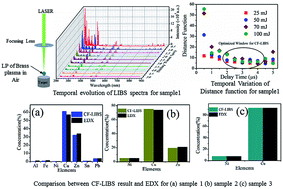Optimization of temporal window for application of calibration free-laser induced breakdown spectroscopy (CF-LIBS) on copper alloys in air employing a single line
Abstract
In the present work, the transient evolution of laser induced plasmas (LIPs) of three different copper alloys are reported in order to identify the optimum temporal window for the implementation of calibration free laser induced breakdown spectroscopy (CF-LIBS) for quantitative analysis. The laser induced plasma (LIP) is generated on the copper alloys in air by focusing the second harmonic of a Q-switched Nd:YAG laser of pulse width ∼7 ns and a repetition rate of 1 Hz. From LIBS spectra it is observed that sample 1 (commercial brass) is comprised of copper (Cu) and zinc (Zn) as the major constituent elements along with the trace elements aluminum (Al), iron (Fe), lead (Pb), tin (Sn) and nickel (Ni), while sample 2 is comprised of Cu, Zn and Ni and sample 3 contains only two elements: Cu and Ni. The accuracy of the CF-LIBS technique depends immensely on the validity of local thermodynamic equilibrium (LTE) and the optically thin condition of the plasma. From the temporal evolution of the LIP, the optimum temporal window is identified where LTE as well as the condition of an optically thin plasma hold together. For this, the temporal evolution of the plasma temperature is studied from the emitted atomic copper transitions via a Boltzmann plot and that of the electron density from the Stark-broadened profile of the CuI (510.5 nm) line. The estimated plasma parameters are used in a one line CF-LIBS algorithm to determine the percentage composition of all the elements present in all three samples. Sample 1, comprising seven elements, is studied first at four different laser energies of 25, 50, 75 and 100 mJ. It is observed that the LTE and optically thin condition of the plasma are well satisfied in the optimum temporal window of 2–4 μs with respect to (w.r.t) the incidence of the laser pulse. The relative errors in the estimation of the concentrations of trace elements are at a minimum at 50 mJ compared to those at other energies. So the other two samples are studied at 50 mJ of laser energy only. The CF-LIBS results within this optimum temporal window for all the samples are also found to be in good agreement with the EDX results.



 Please wait while we load your content...
Please wait while we load your content...